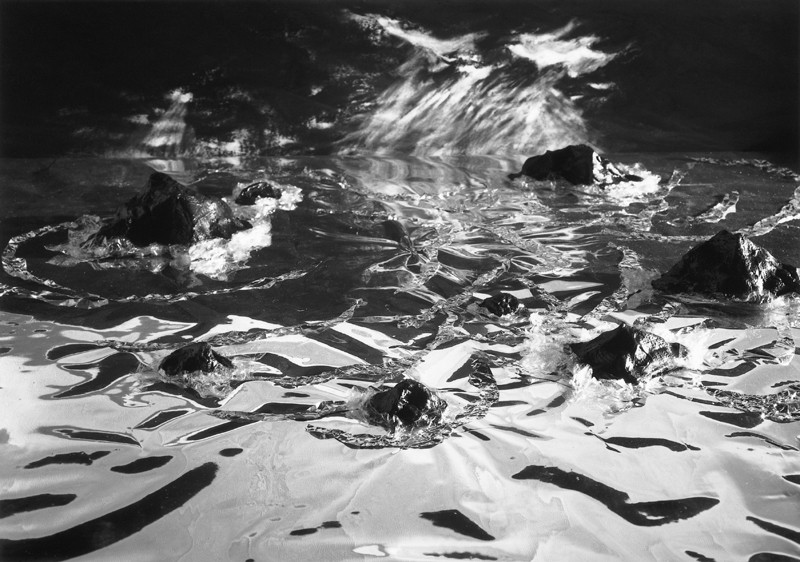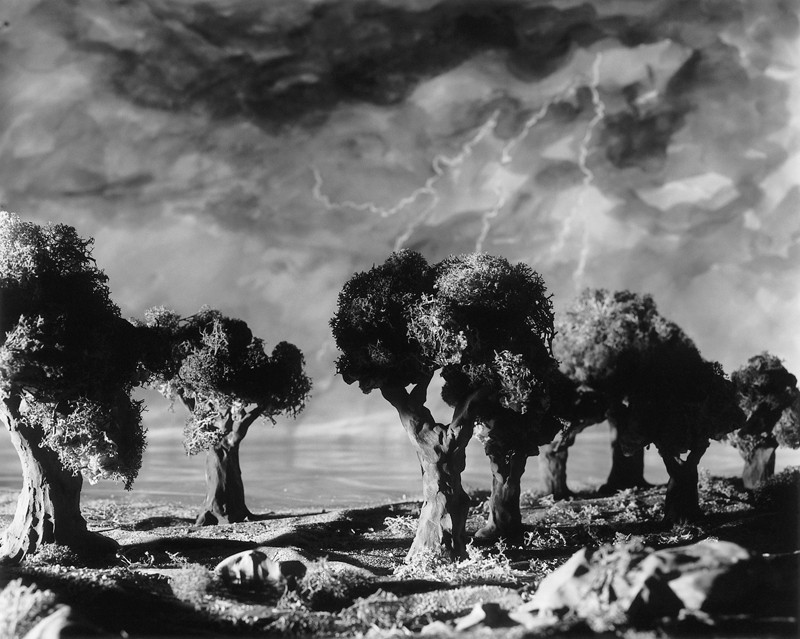[Fall 1998]
by Gary Michael Dault
Every photograph is constructed. In the usual order of events, however, a photograph is “constructed” first perceptually, then chemically or is otherwise processed in the tiny silicon bath of the computer and, finally, as an artefact.
Holly King’s photographs represent an amplification and a reversal of this order of events. Whatever the imaginative parti that quickens into a new work for King, there is, when she begins, nothing to see. She starts with the physical contriving of her constructed landscape or faux environment, lights it (hovering, omniscient, over the scene like a film director), and then photographically assists it into objecthood. A tide of perceptual engagement with the work at last brims toward the artist herself only shortly before it reaches us.
Not since the early 1980s have King’s photographs incorporated the presence of the human figure. Her first staged photoworks, such as those from the Hellenic Winds series (1982), were derived from her earlier role as performance artist. The photographs were like large theatrical stills of live events featuring King herself. When she withdrew from her photographs, King replaced herself with built surrogates, traces of culture abandoned in the wilderness of a nature of her own devising such as the eerily lit, out-of-focus gazebo occupying the middle distance of Place of Desire (1989), a scale-less, ambiguously located, unknowable gazebo, attainable, as Francine Dagenais noted in Canadian Art (Winter, 1989), “only through oneiric paths.”
In her later works, there are not even shards or ruins of the human fact to cling to, no fabricated passages of socialized flotsam and jetsam by which to calibrate one’s imaginative trajectory into the works. Free of the perceptual slowdown generated by recognizable domesticated artefacts in her photographs (in this regard the cardboard railing in the foreground of Lookout, 1988, represents a virtual jumping-off point for King), the artist was now able to freefall into the larger vistas of her new homemade/handmade sublime. Works such as Approaching Disturbance, Vanished, and The Viewless Winds, all from 1995, are majestically bleak and empty, often (in Vanished and The Viewless Winds) structured around an endlessly receding horizon toward which the foreground appears, formally speaking, to yearn (this is especially so in Vanished, where ribbons of some wet, shiny material flow like rivulets toward a vanishing point in the dark, ersatz, boulder-like contrivance that appears to mark Land’s End; the picture always replays, in my memory, Swinburne’s lines to the effect that “even the weariest river winds somewhere safe to sea”). Here, amid these unreal rock islands emerging from King’s mirror-and-Saran-Wrap oceans so far removed, in the impress of their artifice, from the mnemonic is a contrived lunar pull toward the unknowable. These vast black-and-white photographs have always struck me as stately embodiments of an almost overwhelming emptiness and loss (where loss is presented geographically as unremitting distance) which may well be some manifestation of the death of King’s infant daughter, Olivia Rose, in 1994.
And King’s employment of colour may also be emblematic of a sense of acceptance and recovery. Her first constructed responses to her dreadful loss – in photographs such as Memorial Rose (1995) – used brillant colour almost as overcompensation for the memorializing blacks and whites that had gone before. Here, in trumpet-loud, hot-hued proclamations of emotional struggle, the temporariness of rose petals contests with the eternal hardness of bright jewels in the hope of eternal remembrance. In Rose Remembered (1997), the lost child is a perfect glass sphere of infinite wholeness, encircled by a penumbra of her namesake roses.
In the later landscapes works such as The Veiled Forest and The Stillness of Absence, both from 1997 there is more slippage and contesting between foreground and background than before, more hard visual incident: the trees, solid as plasticine, with stunted broccoli-esque tops like props for a model railroad layout, punctuate landscapes strewn with Styrofoam-like rocks, unconvincingly heavy. The new skies crackle luridly with willed lightning (The Stillness of Absence), or are occluded with febrile membranes (The Veiled Forest), rent for us so that we might gain (the curtains now drawn apart) imaginative entry to the tableau. The memorializing impulse is now, touchingly, modulating into a sullen kinetic burn energizing enough to fuel a new progress into the unknown landscape lying ahead.
Toronto-based writer and art critic Gary Michael Dault is an adjunct associate professor at the School of Architecture in the University of Toronto. He is the author, most recently, of Flying Fish and Other Poems (Exile, 1996). He is a regular contributor to a number of Canadian arts and culture magazines and to The Globe and Mail.







